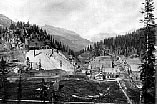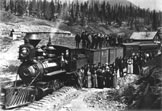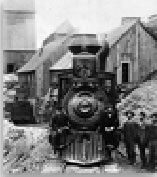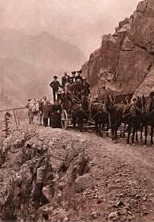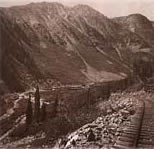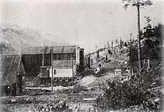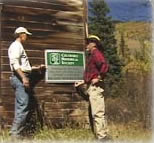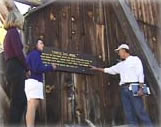RED MOUNTAIN MINING DISTRICT
|
For a little more than a decade at the end of the nineteenth century, the Red Mountain Mining District in Southwestern Colorado was one of the richest and most productive in the world. The story of Red Mountain is perhaps an amalgam of many of the western boom-and-bust mining cycles, and it took place in one of the highest and most beautiful places on the North American continent. It was evident to even the earliest casual observer that there must be precious minerals in the three gaudy-colored Red Mountains. The colors came from iron pyrite - fool's gold - but it was an obvious clue that other richer minerals could be close by. Only low grade discoveries were made in the first few years of mining activity. But in 1882 John Robinson discovered the fabulously rich Yankee Girl Mine and the rush was on to Colorado's newest mining district. What had fooled the prospectors was that the ore was to be found in vertical chimneys rather than in lode deposits typical of the area. The Red Mountains themselves consisted almost entirely of very low grade ore except where the rich ore chimneys of some thirty to one hundred feet in width plunged into the earth. There silver could be found that contained as much as 1,000 ounces of silver per ton of ore - an unheard-of richness. As word of the rich strikes spread, prospectors quickly flowed into the Red Mountain area. The nearby towns of Silverton and Ouray fought to become known as the entry point into the district. Each touted that it was the only way into the area and warned of the dangers that faced the poor soul that dared to venture into the Red Mountains from the other direction. Each sponsored newspapers up on the divide which featured their own favorite town. Soon other rich discoveries were located at the Congress, Guston, National Belle and many smaller mines. Each of the towns was almost an equal distance from the new discoveries and better transportation was badly needed to bring the rich ore out to market. Ouray immediately built a wagon road across steep "impassable" cliffs into the heart of the new discoveries. It eventually became known as the famous Million Dollar Highway. At about the same time it became evident that the really rich ore was on the Ouray side of Red Mountain Divide. But Silverton countered with the completion of the Silverton Railroad into the Red Mountain district. The short little twenty-mile railroad that Otto Mears, "the Pathfinder of the San Juans," built is today one of the most historic and well known of all the narrow gauge railroads in Colorado. It carried the nickname of "The Rainbow Route" as it reached forward to a pot of gold (perhaps really silver in this case), and it arched across the steep Red Mountain Divide like a rainbow in the sky. Millions of dollars in capital was poured into the Red Mountain district by rich Eastern and European investors, many of whom were being brought directly to the mines in luxurious coaches on the new railroad route. Soon towns began to appear on the mountains themselves. Red Mountain City was originally located on the Silverton side of the pass, then relocated to the Ouray side and again moved to near the National Belle Mine when it was evident that the new road and the railroad would pass through that point. Stores and homes were literally jacked up and hauled by teams of horses from one point to the other. Small towns such as Congress and Guston grew up at some of the local mines. Other towns like Ironton and Chattanooga were built at lower elevations to serve as supply points to the mines located high in the nearby mountains. Post offices, hotels and, of course, numerous saloons sprouted as quickly as the local alpine wildflowers in these locations. Thousands of men soon lived in these hastily built towns. Some of the structures that were built in the winter leaned precariously when the spring thaws came. Hundreds of women and children followed their men to these dangerous spots. Land promoters and mining speculators stood to do as well financially as the original prospectors. Lawyers and stockbrokers made small fortunes. The merchants, saloonkeepers and the ever-present prostitutes made quick, easy money. But there was a high price to pay for living in such a high elevation surrounded by steep mountains that carried deadly avalanches upon the unsuspecting traveler below. The snow sometimes piled up so deeply that all work came to a halt as the ore couldn't be shipped and the storage bins were completely full. Then armies of miners took to the roads and tracks to clear the snow, only to find that it was necessary to return to this work time and time again. Nighttime temperatures dipped to twenty or thirty below zero but it could be shirt sleeve weather in January when the sun was shining. There were other hardships in the mines. The ore went straight down so vertical shafts followed the rich metals for hundreds of feet into the bowels of the earth. Water was a constant problem, but the same water when mixed with the local pyrites formed sulfuric acid which in turn ate at the pumps and also at mine rails, shovels and the mining machinery. Nails dissolved in the rungs of ladders, planks fell from ceilings and hoist cables could turn to rust in a month's time. Even with such dangers and the often cramped conditions of twenty men living in a single room, the Red Mountains were actually touted as one of the healthiest spots in Colorado. The water was pure there and the cold temperatures perhaps contained many potential illnesses that would have flourished in the more squalid mining camps. There were reportedly only four people over a twenty-year span who died from sickness; yet many a man met his Maker on Red Mountain as the result of mining accidents, snow slides or gunshot wounds. Millions of dollars were eventually taken out of the Red Mountains. During its heyday the mining district was surpassed in Colorado only by Leadville. Millions of dollars were also poured into the district by wealthy investors who were as anxious to strike it rich as the local prospectors. All told it is estimated that upwards of thirty million dollars in silver, lead, zinc, copper and gold were taken from the Red Mountain Mining District in a few short decades. At today's prices that production would come close to a quarter of a billion dollars. After the Silver Panic of 1893, Red Mountain mining was never the same. The Silverton Railroad cut back service, shortened the line and then was abandoned in 1922. After the heyday there was some gold discovered in the district and a few mines continued to operate up until as recently as the 1970s. Red Mountain Town burned in 1892, was rebuilt, burned again two years later, was partially rebuilt, and then burned again in a forest fire in 1939. About the turn of the century millions of dollars were invested in grand ventures at the Joker and Meldrum tunnels - efforts to strike known ore at lower levels. But the ore seemed to generally lose value the deeper the miners went and these ventures also eventually closed. In the 1930s the Idarado Mine opened, and it continued to mine rich ore hidden deep within the mountains until the 1970s. Now Red Mountain is silent. The outline of the railroad grade is only faintly visible. The snow flattens buildings, and treasure seekers carry away anything remotely usable or collectible. A mere handful of mine buildings still stand. Only a few men still work in the area, mainly doing environmental cleanup. The rains and winds cause the dumps to slowly flatten out and disappear. Every year less and less of man's accomplishments remain and more of the land returns to its original state. The same winds, deep snows, acids, fires and snow slides that made life so dangerous and difficult a hundred years ago, now quickly destroy what man has left behind. Yet men and women laughed and danced and sang and died here. Children were born and raised. Heroic deeds were performed and yet a great deal of damage was done to perhaps the most beautiful land in North America. There are still lessons to be learned here. Further Reading: Brown, Robert L., An Empire of Silver, Caldwell, Idaho, The Caxton Printers, 1966. Gregory, Marvin & Smith, P. David, Mountain Mysteries, Ouray, Wayfinder Press, 1984. Sloan, Robert E. and Skowronski, The Rainbow Route, Denver, Sundance Books, 1975. Smith, P. David, Mountains of Silver, Ouray, Western Reflections, 1994. Wolle, Muriel Sibbell, Stampede to Timberline, Chicago, Swallow Press, 1974 Nossaman, Allen, Many More Mountains, Vol. 3, Sundance Books, 1998
|
| Historic Preservation | Recreation | Photo Gallery | Contact Us | Home |



